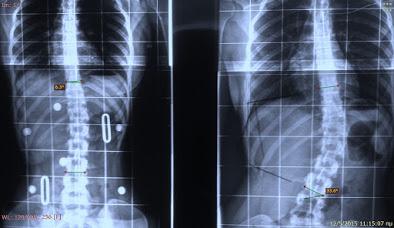by Bridget
X-ray Scoliosis Giourgou
Watching Elise Browning Miller's recent interview with Christine Jaureguiberry (on Christine's Yoga for Scoliosis Community Youtube channel), I was particularly interested in their discussion about adult onset scoliosis. Teen years and puberty tend to be the main focus for when scoliosis develops, but as scoliosis is more prevalent in women than in men (8:1), there is evidence that periods of major hormonal fluctuation (childbirth and menopause) can trigger a later change in spinal structure. Age can contribute, with degenerative discs, softening of tissues, and arthritis, so that an adult can develop a curve that they previously did not have at all. But it's also possible to have a mild, idiopathic scoliosis that remains nearly undetectable throughout life, which then increases after menopause.
Nina addresses the prevalence of adult-onset scoliosis in her post Late-Onset Scoliosis is Common in Older Adults, discussing her own experience with scoliosis in her fifties. She also gives an overview of scoliosis and yoga in a more recent post Scoliosis and Yoga: The Big Picture, where she provides links to all of the posts on scoliosis over the years on the Yoga for Healthy Aging blog.
For individuals diagnosed with a spinal curve, it's common to feel pain in a hip or leg, or in your back, and this is often the reason a diagnosis is sought out. Elise talks about the importance of developing a regular (daily) practice that addresses the specific curve(s). She recommends starting off simply, maybe just figuring out a few poses that work and getting into a regular routine of body focus while doing this practice. In her book Yoga for Scoliosis - A Path for Students and Teachers, she offers many options for creating a routine as well as a more complex dive into the specifics of an individual's own curve pattern, or "body map," and ideas for addressing each one.
Elise says in the interview that her goal is to empower students, as she had been empowered as a teenager to take control of the management of her own curve. In her book, she explains that her initial diagnosis was accompanied by a prescription for immediate surgery. Luckily she found her way to an orthopedic surgeon who was thinking way ahead of his time, and who recommended holding off on surgery and looking into yoga instead. Elise stresses that you can make a change. Yoga can correct your curve, or at the very least, keep it from progressing. And the big first step is creating awareness of your body and the way it works around the curve. A quote from Ida P. Rolf is mentioned by Christine, "Put it where it belongs and then move it." In other words, it almost doesn't matter which poses you practice, as long as you get your awareness and alignment on board before attempting the pose. Of course, awareness of our alignment is a skill that is developed over time (which means you can just keep practicing yoga and keep learning indefinitely). Elise brings this one step further to say that the awareness of the yoga practice should cross over into everyday life: walking, bending, and lifting. Another quote, from Prashant Iyengar (BKS Iyengar's son), who saw the danger of being too focused on adjustments to get it just right, suggested putting an end cap on the possibility for endless adjusting with, "Adjust, adjust and then settle in."
If you are dealing with mysterious chronic pain in a hip or leg, or in your back, you might mention it to your doctor, who could rule out a developing curve. The wonderful thing about Elise's teaching and her book is that building body awareness is key to optimal functioning, whether you have a curve or not, so following her direction on tuning into your body is a good plan for everyone!
Find information on Bridget's current classes here.
Subscribe to Yoga for Healthy Aging by Email ° Follow Yoga for Healthy Aging on Facebook ° To order Yoga for Healthy Aging: A Guide to Lifelong Well-Being, go to Amazon, Shambhala, Indie Bound or your local bookstore.


